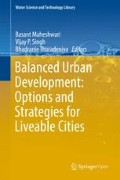Abstract
A major challenge we face globally is that cities are growing rapidly and most of this growth is inevitably is occurring in peri-urban areas. The concept of balanced urban development is complex and is linked to liveability of urban areas along with water, food and energy security. Increasingly, liveability is becoming important for urban planners and governments at all levels. There are many environmental, economic, political and social challenges if the goals of achieving sustainable, liveable and productive urban regions are to be achieved. The concept of sustainable development and liveable cities symbolise the big visionary ideas for urban planning and balanced development but implementation of these popular visions can encounter a host of conflicts due to a range of interests and stakeholders involved. The process of achieving balanced urban development may require learning from the past successes and mistakes to identify what makes a good practice for balanced urban development and guide local governments, planning agencies and developers to plan and design future cities that are highly liveable. At present there is insufficient policy focus on the challenges of the peri-urban areas of growing mega-urban regions around the world, because they are not recognised as an integral part of the functional activities that drive the growth of these urban areas. Thus, policies for peri-urban regions have to be given priority at both national and global levels, if ‘globally just urban places’ are to emerge.
References
Berke PR (2002) Does sustainable development offer a new direction for planning? Challenges for the twenty-first century. J Plan Lit 17(1):21–36
CISS (2013) Food security in Asia – a report for policymakers. Centre for International Security Studies, University of Sydney, Sydney, 32p. http://sydney.edu.au/arts/ciss/research/food_security.shtml. Accessed 15 Aug 2015
Cohen B (2006) Urbanization in developing countries: current trends, future projections, and key challenges for sustainability. Technol Soc 28(1–2):63–80
de Haan FJ, Ferguson BC, Adamowicz RC, Johnstone P, Brown RR, Wong TH (2014) The needs of society: a new understanding of transitions, sustainability and liveability. Technol Forecast Soc Chang 85:121–132
Godschalk DR (2004) Land use planning challenges: coping with conflicts in visions of sustainable development and livable communities. J Am Plan Assoc 70(1):5–13
Goldberg A, Leyden KM, Scotto TJ (2012) Untangling what makes cities liveable: happiness in five cities. Proc ICE Urban Des Plann 165(3):127–136
McGee T (2009) The spatiality of urbanization: the policy challenges of mega-urban and Desakota Regions of Southeast Asia. UNU-IAS Working paper no. 161. www.as.unu.edu/resource_centre/161%20Terry%20McGee.pdf
Ruth M, Franklin RS (2014) Livability for all? Conceptual limits and practical implications. Appl Geogr 49:18–23
Schebella M, Weber D, Brown G, Hatton MacDonald D (2012) The importance of irrigated urban green space: health and recreational benefits perspectives. Goyder Institute for Water Research, technical report series No. 14/2, 30p
United Nations (2009) Urban and rural areas 2009. Department of Economic and Social Affairs, Population Division. http://www.un.org/en/development/desa/population/publications/urbanization/urban-rural.shtml
United Nations (2011) Population distribution, urbanization, internal migration and development: an international perspective. Department of Economic and Social Affairs, Population Division, Publication no. ESA/P/WP/223, 363p
Author information
Authors and Affiliations
Corresponding author
Editor information
Editors and Affiliations
Rights and permissions
Open Access This chapter is distributed under the terms of the Creative Commons Attribution-Noncommercial 2.5 License (http://creativecommons.org/licenses/by-nc/2.5/) which permits any noncommercial use, distribution, and reproduction in any medium, provided the original author(s) and source are credited.
The images or other third party material in this chapter are included in the work’s Creative Commons license, unless indicated otherwise in the credit line; if such material is not included in the work’s Creative Commons license and the respective action is not permitted by statutory regulation, users will need to obtain permission from the license holder to duplicate, adapt or reproduce the material.
Copyright information
© 2016 The Author(s)
About this chapter
Cite this chapter
Maheshwari, B., Singh, V.P., Thoradeniya, B. (2016). Balanced Urban Development: Is It a Myth or Reality?. In: Maheshwari, B., Thoradeniya, B., Singh, V.P. (eds) Balanced Urban Development: Options and Strategies for Liveable Cities. Water Science and Technology Library, vol 72. Springer, Cham. https://doi.org/10.1007/978-3-319-28112-4_1
Download citation
DOI: https://doi.org/10.1007/978-3-319-28112-4_1
Publisher Name: Springer, Cham
Print ISBN: 978-3-319-28110-0
Online ISBN: 978-3-319-28112-4
eBook Packages: Earth and Environmental ScienceEarth and Environmental Science (R0)

